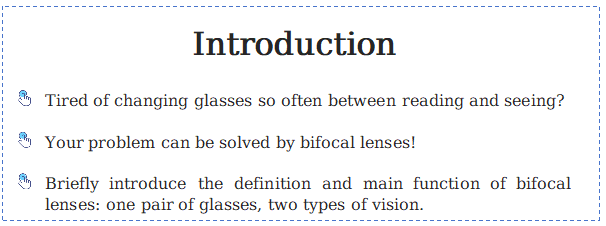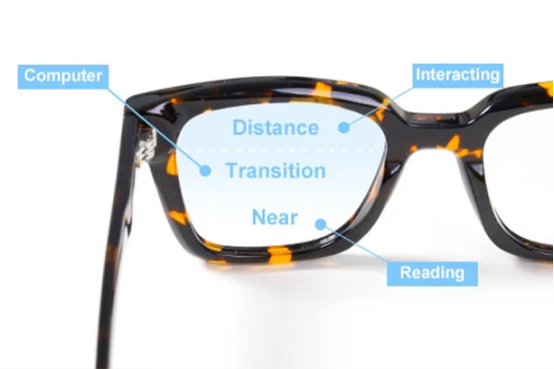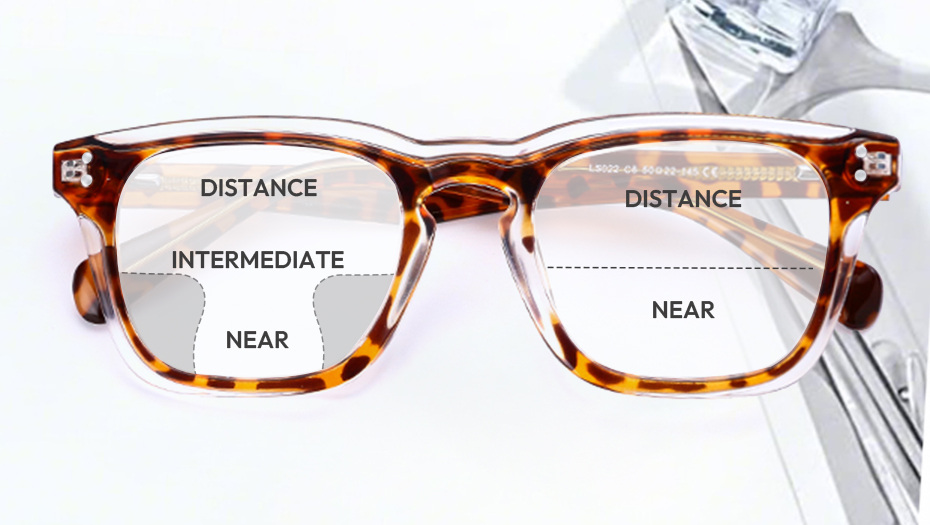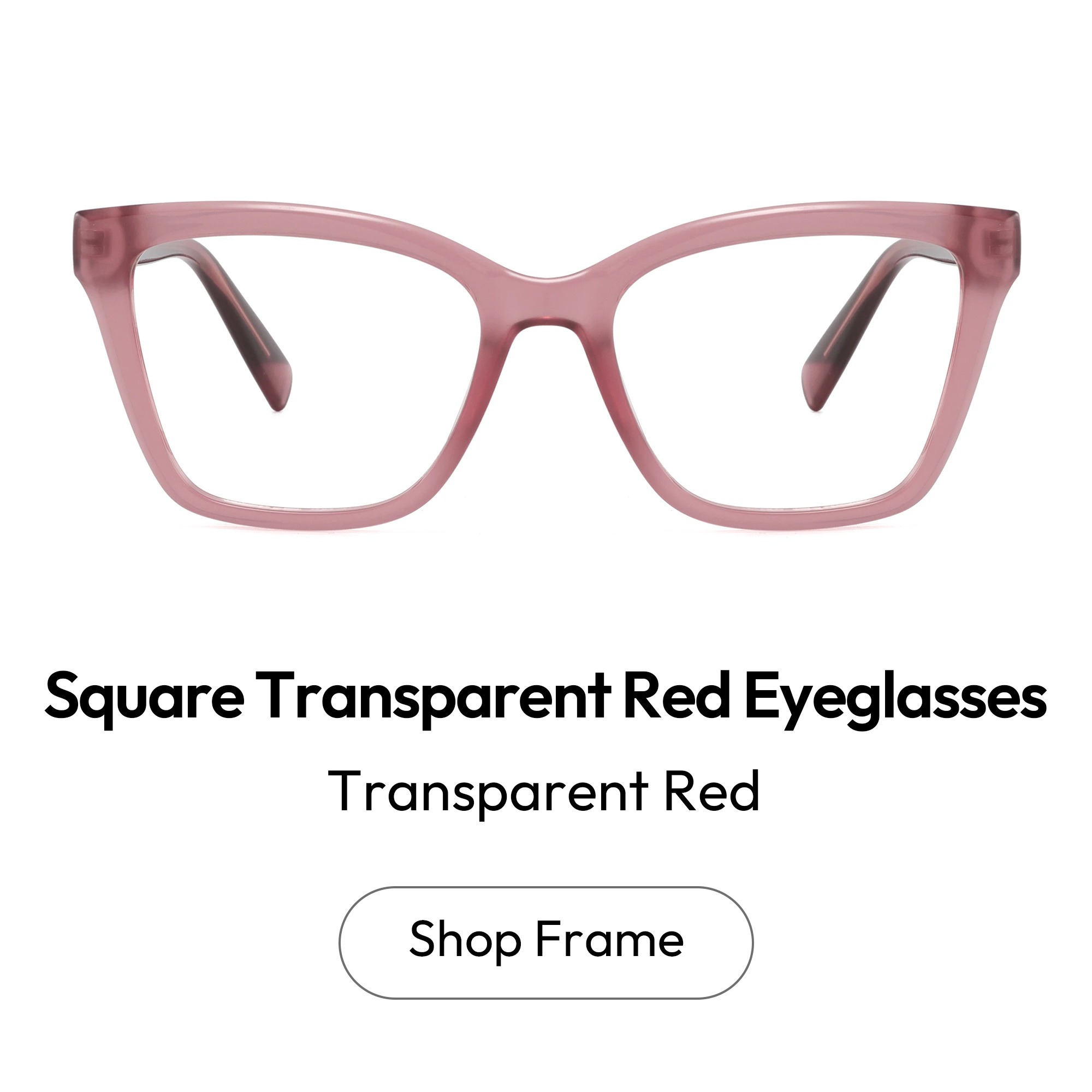- GlassesShop By FrameShop By StyleFeatured














What Are Bifocal lenses
Definition and Basic Function
A bifocal lens is a specially designed optical lens with multiple focal segments, integrating two distinct prescriptions into a single lens. In typical usage, the larger area is set with a distance prescription (ideal for activities like driving or watching movies), while a smaller reading segment is designated for near vision tasks (such as reading books or using a smartphone). This type of lens is primarily used to address blurry near vision caused by presbyopia—a natural, age-related decline in close-up vision that commonly begins between the ages of 40 and 45.
With a clear understanding of its core purpose, we can now delve into how this smart optical structure functions.

How It Works
A bifocal lens provides visual clarity at multiple distances by dividing the lens into zones:
· The main viewing area, located in the upper portion and comprising about 70–80% of the lens surface, is dedicated to distance vision, ensuring clarity for mid-to-long range tasks like walking or driving.
· The reading segment, acting as a functional aid, is usually embedded in the lower part of the lens. This “window” is optimized for near vision tasks within 30–40 cm.
· Users can switch focus by naturally lowering their eyes, eliminating the inconvenience of constantly changing eyewear and achieving efficient vision management with just one pair of glasses.
The evolution of bifocal lenses is deeply rooted in the advancement of optical craftsmanship, spanning over three centuries and closely aligned with human visual needs.
Historical Background
The history of the bifocal lens dates back to 1784, when Benjamin Franklin, one of the Founding Fathers of the United States, invented the first version to address his presbyopia. He ingeniously combined two separate lenses—one for distance and one for near vision—by cutting and bonding them vertically. This early prototype, known as "double spectacles," is the predecessor of today's bifocals. Due to its distinct horizontal separation across the lens, this style was later named the Executive type, which is still favored by certain users for its stable visual field.
A major milestone came in 1824, when John Isaac Hawkins, inventor of the trifocal lens, coined the term “bifocal”, marking a significant step toward the systematic development of multi-focal vision correction.
Over two centuries of technological refinement have led to a wide range of bifocal lens variations, each tailored to different user needs. In the next section, we will explore the main types and their design features in detail.
The Technical Evolution and Modern Forms of Bifocal lenses
1. Bifocal Lens Designs in Traditional Eyeglass Frames
(Continuing from the historical prototypes mentioned earlier, modern bifocal lenses in eyeglass frames have developed along two major technical paths)
a. Segmented Bifocal lenses
As a classic design model, this type of bifocal lens features a visible boundary between distance and near vision zones, achieved through either physical cutting or fusion processes. Key technical characteristics include:
· Diverse shapes :
o D28 : A D-shaped reading window with a horizontal span of 28mm
o Round segment (Round seg) : Circular reading zone
o Executive style : Full-width lower segment across the lens
· Vision-switching mechanism :
The eye naturally moves downward to switch focus, with the distance zone occupying 65–85% of the lens area
· Adaptation advantages:
Low image jump (switching time < 0.3 seconds) and stable visual output, making them ideal for professionals needing precise focus—such as accountants or operators of precision instruments
b. Progressive Addition Lenses (PALs)
Although often grouped with bifocal lenses, progressive lenses represent an independent branch of optical innovation. They use a gradual curvature design to provide a continuous shift in lens power (typically from +0.25D to +3.50D) from the top (distance vision) to the bottom (near vision), with an intermediate corridor covering the 80cm–40cm range.
· Technical benefits:
Eliminate visible segment lines and allow seamless focus adjustment via smooth horizontal eye movement (usually requiring 2–7 days of adaptation)
· Prescription considerations:
Both outer edges of the lens include more than 15% tapered zones, often requiring subtle head movement for optimal viewing. Initial wearers may experience slight dizziness during the adaptation period
2. The Optical Revolution of Bifocal Contact Lenses
Modern corneal contact lenses are also advancing toward achieving balanced multi-zone vision. The most widely used bifocal lens models in contact lenses can be categorized as follows:
Technology Type | Optical Structure | Ideal Usage Scenarios |
Aspheric Design | Simulates zoned vision by separating focus areas across top/bottom/inner/outer regions | Dynamic environments where fast focus switching is essential |
Multizonal Concentric Rings | 5 to 7 alternating near and distance rings (diameters ranging from 0.2 to 1.2 mm) | Office settings, multitasking activities requiring mid-range focus |
Clinical findings:
Successful prescription of bifocal contact lenses requires corneal topography assessments and tear film stability testing (TFBUT > 10 seconds). These lenses can enhance stereoscopic vision by more than 30%.
Factors to Consider When Choosing Bifocal lenses
When faced with a wide range of lens options, the bifocal lens stands out for its practical ability to bridge both near and distance vision. However, as with any vision aid, users should carefully weigh both the advantages and limitations before making a decision tailored to their individual needs.
Pros and Cons of Bifocal Glasses
The biggest advantage of a bifocal lens is its convenience—it allows wearers to manage both near and far vision needs with a single pair of glasses. For middle-aged and older adults who frequently shift focus between distances throughout the day, this can be a major benefit. In addition, bifocal lenses are generally more affordable than progressive lenses, and because the vision zones are clearly separated, they may be easier to adapt to for certain users.
However, bifocal lenses do come with some limitations.
First, users need to consciously shift their gaze to access the correct prescription area, which may require an adjustment period, especially for first-time wearers. Also, because the transition between the upper and lower prescriptions is abrupt, some individuals may experience visual jumping or discomfort.
From an aesthetic perspective, the visible line dividing the lens may not meet the style preferences of all consumers. Moreover, for those who frequently look down at near-ground objects—such as steps or curbs—the slower transition can cause blurry vision or even pose safety risks.
During extended periods of computer work, since the reading zone is located at the bottom of the lens, users may need to tilt their heads upward, potentially leading to eye strain or neck discomfort over time.
Finally, due to the structural design of bifocal lenses, there are some limitations in terms of lens thinness, tinting, and customization for aesthetic preferences.
Considerations for Bifocal Contact Lenses
In addition to traditional frame styles, bifocal lenses are also available in contact lens form—offering a frameless alternative for users who value appearance or mobility. These lenses retain the multi-focus function without affecting one’s external look, making them a flexible option.
However, bifocal contact lenses usually require a period of adaptation, and the clarity of vision can vary depending on the lens design. Therefore, a professional eye exam and fitting by an eye care specialist is essential to ensure that the selected lenses are well-suited to the wearer’s specific vision needs.
Who Should Consider Bifocal lenses?
A bifocal lens may be ideal for:
· Individuals who need both distance and near vision correction
· People in the early stages of presbyopia who often read and observe objects at a distance
· Wearers who prefer clearly defined vision zones
· Budget-conscious consumers seeking an all-in-one eyewear solution
When Might Bifocal lenses Not Be Suitable?
If your daily visual needs are mostly focused on intermediate distances (such as computer screens), or if you prefer a lens without visible lines and with smoother visual transitions, you may be better suited for progressive lenses.
Additionally, users with higher aesthetic preferences may opt for no-line lens designs or bifocal contact lenses for a more discreet solution.
 |  |  |
How to Adapt to Bifocal lenses
When you first start wearing bifocal lenses, it's completely normal to run into a few hiccups—things like slight blurriness, trouble focusing, or your eyes feeling a bit “off” when looking around. That doesn’t mean you’ve chosen the wrong pair. It simply means your eyes and brain need a bit of time to get used to the multi-focus structure and the way vision transitions between zones. The good news? A few small adjustments to your daily routine can make the transition surprisingly smooth.
Start with low-pressure, static activities
The easiest way to get used to your bifocal lenses is by easing into them through activities that don’t require constant visual switching—reading, checking your phone, or watching something on your tablet. These usually only rely on the lower, near-vision portion of the lenses. By starting with these kinds of static tasks, your eyes can calmly adjust to the reading zone without the stress of movement or distance shifts. Over time, your eyes will naturally learn how to look downward and lock in on clarity, building that intuitive “look down to read” habit.
Adjust your screen height to relieve your eyes and neck
If you spend hours a day in front of a screen, you might be surprised how much the monitor height affects your comfort. Because the reading zone of bifocal lenses sits at the bottom of the lens, a screen placed too low forces your eyes to dip into the wrong zone—leading to blurry text and an awkward, strained posture. That’s when eye fatigue and neck stiffness start kicking in. A simple fix like slightly raising your screen or adjusting your chair height can make a huge difference. The goal is to keep the screen aligned with the upper part of your lens, where your distance vision works best.
Keep your head up when walking—stability matters more than clarity
Whether you're walking outside, going up stairs, or stepping off a curb, your eyes naturally glance downward to see what’s ahead. But when you do that with bifocal lenses, you're likely shifting into the near-vision zone unintentionally—making the ground appear blurry or distorted. That can throw off your sense of depth and cause stumbles. During the adjustment phase, try slowing down your pace and raising your line of sight just slightly so you're relying on the main viewing zone of your lenses. Once you're familiar with how the zones work, you'll move more confidently and naturally.
If you drive, speak up during your eye exam
Driving involves a mix of visual distances: watching the road ahead, checking the dashboard, glancing at navigation. If your bifocal lenses have a reading zone that's too large or too high up, it could interfere with how clearly you see your speedometer or infotainment screen. The key is communication. Let your optometrist know from the start that you drive frequently. They can tweak the lens design to suit your driving habits—whether it’s adjusting the reading zone placement or recommending a specific frame shape. The lenses can be customized more than you think, as long as your needs are clearly stated.
Comparing Bifocal lenses with Other Vision Correction Options
When it comes to correcting vision, the options available today are more varied than many people realize. It’s not just about single vision or progressive lenses—there are also contact lenses, laser surgeries, and even hybrid solutions. So where do bifocal lenses stand among these choices? What makes them appealing, and who are they best suited for? Let’s break it down comparison by comparison:
Bifocal lenses vs. Progressive Lenses
Both solutions address the challenge of needing to see clearly at multiple distances, but they do it in very different ways. Bifocal lenses have a distinct line separating the distance and reading zones. This sharp separation allows wearers to switch between focal lengths quickly and with minimal effort. Many people adapt almost instantly, without feeling disoriented or struggling to find the right focus zone.
On the other hand, progressive lenses offer a smooth, seamless transition from far to near vision, without any visible lines. While this sounds elegant, it can also lead to adaptation issues—some people experience dizziness, blurry peripheral vision, or difficulty locating the "sweet spot," especially when wearing them for the first time. Once adapted, progressives do offer better intermediate vision, but for those seeking immediate clarity and low-maintenance use, bifocal lenses tend to come out ahead.
Bifocal lenses vs. Single Vision + Reading Glasses
This is a classic choice for many older adults—one pair for distance, one for near, switching as needed. At first glance, it sounds flexible. But in practice, it’s often more trouble than it’s worth. Forgot your reading glasses? Good luck checking your phone in public. Constantly swapping between two pairs isn’t just inconvenient—it’s a lifestyle interruption.
Bifocal lenses combine both prescriptions in one pair of glasses, eliminating the hassle of switching back and forth. For people with fast-paced routines or who value practicality, this all-in-one approach is simply more efficient.
Bifocal lenses vs. Single Vision Contacts + Reading Glasses
Some people—especially younger users—wear single vision contact lenses and carry around reading glasses for near work. It might seem like a versatile setup, but it often disrupts visual flow. You need to pause, reach for your glasses, and adjust every time you want to read. The process becomes tedious,
especially during meetings or on the go.
With bifocal lenses, everything is built into a single visual tool. Whether you're writing a report, checking your phone, or reviewing a presentation, your eyes naturally shift between focal areas—no added accessories or interruptions. It's a smoother, more elegant solution for multitasking.
Bifocal lenses vs. Monovision Contacts
Monovision means wearing one contact lens for distance and the other for near vision, relying on your brain to blend the images together. It sounds clever in theory, but not everyone adapts well to having each eye serve a different function.
Many users report a loss of depth perception or visual fatigue, especially while driving at night or watching a movie. Bifocal lenses, by contrast, give both eyes access to near and far correction. There’s no need to “divide roles” between your eyes—just smooth coordination and consistent clarity.
Bifocal lenses vs. LASIK Surgery
Laser eye surgery is often seen as the ultimate fix—get it done once, throw your glasses away forever. But the reality is more nuanced. LASIK doesn't reliably solve presbyopia (age-related farsightedness), and it comes with potential risks: dry
eyes, glare at night, or the eventual need for reading glasses anyway.
In comparison, bifocal lenses offer flexibility and peace of mind. They don’t permanently alter your eyes, have a short adaptation period, and can be adjusted as your vision changes over time. For people who prefer a conservative, low-risk
approach, bifocal lenses are a smart and safe choice.
Shopping for Bifocal lenses at EFE
At EFE, we are committed to providing the most suitable vision correction solutions for users with diverse visual needs. Our bifocal lens collection features a variety of frame styles—from timeless classics to modern fashion-forward designs. Whether you prefer a traditional look or a lightweight, minimalist style, we offer options to suit your personal preferences.
You can explore our latest products anytime on our official website. The shopping experience is simple and intuitive, allowing you to filter by frame type, shape, material, and more. If you have questions about lens design, prescription choices,
or how to wear bifocal glasses comfortably, our experienced optical advisors are here to help. We offer online consultation to guide you toward the most suitable bifocal lens solution.
Before making a purchase, we strongly recommend getting an up-to-date eye examination to ensure your prescription is accurate. This ensures the lenses you choose provide optimal clarity and comfort for your everyday needs.
The bifocal lens is a smart, flexible, and reliable solution for managing both near and distance vision in everyday life. Whether you're navigating the effects of presbyopia or frequently switching between visual tasks, bifocal lenses can bring
noticeable improvement to your overall visual experience.
We encourage you to consult with a qualified eye care professional when choosing your vision correction method. By considering your unique vision habits and lifestyle, you can select the product and solution that best meets your needs.
*This article is for informational purposes only and is not intended as medical advice. If you have any concerns about your vision, please consult a licensed eye care provider for professional guidance and an accurate prescription.

